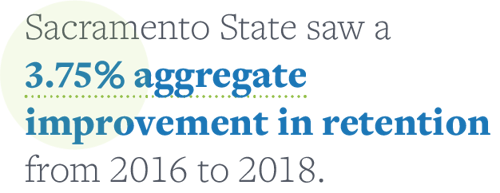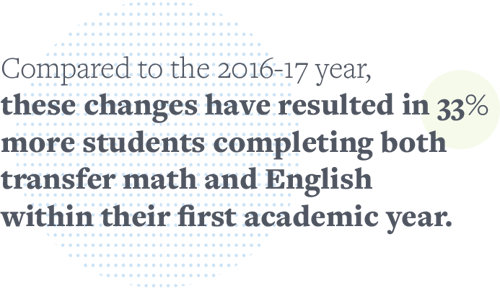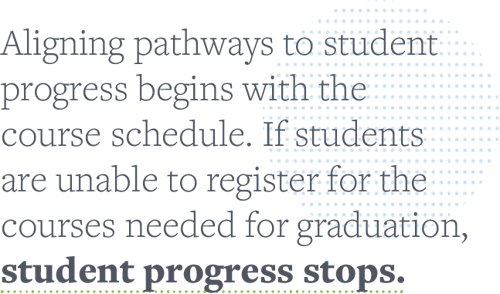
Recently, the industry refreshed Core Principles for Student Success. This report focuses on how the transformation of a remediation strategy can significantly improve student success. It offers seven strategies that higher education institutions and systems can undertake to improve student retention, time-to-completion, and graduation rates in their state and beyond.
All the principles identified by Strong Start to Finish's response to this article align well with recent work undertaken by colleges and universities in partnership with Ad Astra, a leading course scheduling and academic planning organization that seeks to graduate more students faster.
Identify academic direction and supports.
Core Principles for Transforming Remediation within a Comprehensive Student Success Strategy opens with an important tenet. Every student’s postsecondary education must begin with a well-designed process that empowers them to choose an academic direction and build a plan that starts with passing credit-bearing gateway courses in the first year. It’s not simply enough for admissions officers, policymakers, and other relevant stakeholders to craft policies for an individual to gain access and admittance to an institution of higher education. Rather, the first step is to align students to the proper degree plan. However, too often, students may not know the proper course sequence, or even what major they wish to study. Additionally, course availability in first-year courses can be very constrained, causing students to be off track before they even begin. To address this challenge, colleges and universities have developed the "momentum year," which helps ensure that students meet their math and English general education requirements, take nine credits in their major, and 30 credits by the end of their first year. To maximize the likelihood of on-time completion, a “momentum year” provides students with access to success in their first year and beyond by laying a strong foundation for future success.
Recently, Lamar University partnered with Ad Astra to receive targeted data through Momentum Year, an Ad Astra solution that pairs nicely with 15 to Finish. This data highlights students that need early intervention and allows colleges and universities to redirect their students to enroll in the right classes within the first year, which is an early marker for completion. Often, student success is dictated by a student’s first year. Incoming first-year students create the foundation for their remaining time at an institution simply by selecting the number and type of classes they are taking upon freshmen enrollment. This is where academic direction and supports come into play and where Lamar University is distinguishing themselves.
Last spring, Lamar University reviewed Momentum Year data with the intention of using grant and scholarship money to incentivize students to enroll over the summer who were not meeting all Momentum Year standards. This allows at-risk students to make up for deficiencies and get back on track, on Lamar University’s dime.
“We were lucky enough to have unspent aid money in both areas, and my director was all in on spending it on this group,” David Short, University Registrar commented. “Unfortunately, we ran face-first into a global pandemic, and everything sort of fell apart as we started re-applying those funds to more critical areas.”

All that said, David Short’s director is still on board with utilizing this data and using it to improve student success. They are now using Momentum Year to isolate their starting place.
“We have limited resources, and Momentum Year data is helping us target where to spend the resources,” Short continued. “There are a lot of data points that are being used, and we need to understand where to start. This metric helps determine where intervention can begin.”
Currently, Short engages multiple departments to ensure this becomes a reality for students through cross-departmental collaboration. He works closely with the Advising Center and the Scholarships and Financial Aid teams to use data to identify the students that are impacted the most by financial assistance. As national initiatives continue to support Momentum Year, Short has been able to drive home the impact of this intervention using 15 to Finish. By sharing data points with the Advising Center, this center has ammunition to make the final push in aiding student success through their recommendations. Additionally, they can identify the students who need the financial support to increase their credit hour load in order to follow degree maps and 15 to Finish recommendations.
While the narrative has shifted, the outcome is still the same. Lamar University is identifying academic direction and student supports and actively working to implement support functions that truly impact their students. Now, freshmen who were previously ruled out due to financial strain can increase their credit hours within their first year, increasing their degree velocity.
For more insight into the progress Lamar University is making to support students, check out our podcasts on the Academic Planning Resource Center. In a recent episode, Short shares the impact of monitoring registration for Summer and Fall 2020.
Enroll in college-level math and English courses.
By enrolling in college-level math and English courses, students are building a foundation for their collegiate success. In exploring what factors predict first-year student success, academic and testing professionals agree: standardized tests may be a factor but not the sole factor in placing students [1], or understanding why students succeed [2]. Rather, a multitude of factors explain why students are successful in their first year, particularly as it relates to core courses such as math and English. Recent research from Ad Astra has found that net of prior achievement on standardized tests, students who are in a momentum year experience, including taking math and English courses, are more likely to be retained.
Recently, Ad Astra partnered with Sacramento State University to help ensure, that their students received those required college-level math and English courses in their first year as much as possible. This past fall, the College of Arts and Letters piloted a new program to pre-enroll 325 incoming freshmen in block schedules based on a survey about their interests, learning styles, and availability. The results were astounding; only 5% of students opted out of their predetermined schedule, and only 20% of students changed the time for a course - meaning more students were starting on a clear path to graduation. By ensuring that more students take courses like math and English when they need them, more students can satisfy requirements and graduate in four years. Most importantly, effective schedule building and on-time required courses ensure they completed required courses so they can take pre-requisite courses, thereby mitigating cascading delays in subsequent course sequences.

With Ad Astra’s recommendations and tools, Sacramento State continues to strategically add courses to its schedule, leading to an increase in the average number of credit hours taken by a student. From 2017 to 2019, Sacramento State saw a 6.2% increase in first-year student credit hours, a 2.4% increase in sophomore student credit hours, and a 3.3% increase in junior student credit hours. In so doing, Sacramento State saw a 3.75% aggregate improvement in retention from 2016 to 2018. Through more strategic scheduling and capacity management, in addition to other targeted student success strategies, Sac State has witnessed graduation rates increasing from 8.5% to 24.8%, a 192% increase in the aggregate since beginning this work.
Stay abreast on how pre-enrolling freshmen on a larger scale impacts this university knowing their freshmen will at least be “enrolled in college-level math and English.”
[1] https://www.wsj.com/articles/the-truth-about-the-sat-and-act-1520521861
[2] https://jhupbooks.press.jhu.edu/title/measuring-success
Provide support, including embedded, faculty, and staff.
Central to student success is the integrated work of campus communities to transform policies and practices that ensure every student is provided with a high-value learning experience and the support needed to remove barriers to success. This is especially critical for students from historically underrepresented, disenfranchised, and minoritized communities. We often think of college infrastructure as related to the physical plant and maintenance of the physical plant. While that is partially correct, Adrianna Kezar defines infrastructure as “the core features (policies, human resources, physical resources, technology resources, financial resources) of an institution that facilitate daily functions and operations.” We couldn’t agree more and recognize that truly supporting students means providing supports at multiple levels.
Central New Mexico Community College (CNM) is a great example of providing support to students holistically. Hispanic and Native American support is nothing new for CNM. In 2014-2015, these students earned 3,617 associate degrees and certificates, and placed CNM as the No. 1 ranked college in the nation for graduation awards earned by Hispanics and Native Americans. This focus hasn’t stopped and continues to be supported by implementing a student-friendly structure: the schedule.

On a college campus, each individual school often conducts business differently. Understanding this hindering student support, CNM adopted a more centralized approach to assist departmental scheduling practices, increasing campus efficiency. Previously, course scheduling was done in isolation. Now, it’s a more central, collaborative effort. When the goal is increasing degree attainment, structural pieces must be in place to aid students, which is where centralized scheduling comes into play.
This shift to a one-time published schedule has been coined “annualized scheduling,” and largely impacts students. Previously, students were completely altering their lives to accommodate semester-by-semester course schedules. Now, a schedule is set for a year. This new model not only helps traditional students; post-traditional students like Maria Zambrano see the benefits too.
“CNM gives Hispanic mothers the opportunity to continue their careers in business. CNM has been a great support for me because it’s allowed me to continue my studies, to make a career. I’ve had great support from instructors, from the coaches, and all of the staff. It’s an excellent opportunity to enter the workforce,” Zambrano commented.
By students knowing schedules a full year in advance, students that struggle with hectic life schedules can make accommodations. This halts the continuous semester-by-semester life, work, and childcare scheduling shifts, and supports students holistically – especially students from historically underrepresented, disenfranchised, or minoritized communities.
Learn how you can put this support into practice. Visit our equity examples page.
Streamline remediation options.
Traditionally, students who may not have a record of prior achievement that would categorize them as ready for college-level coursework, were placed into a remedial education course. In contrast, co-requisite remediation places students into college-level work, particularly in math and English courses, and provides them extra help to succeed. Research has consistently found that putting students in co-requisite remediation leads to higher course rates, pass rates, and student retention.
About seven years ago, Sierra College recognized it needed to adjust its approach to remediation if students were going to be more successful. Sierra students were not progressing with enough momentum in their first few terms and throughput rates in critical math and English courses were lower than desired. To address this, Sierra developed a “Multiple Measures” approach to early course placement. This approach was largely informed by the work of the RP Group and Long Beach City College and used hybrid analyses of historical success rates in Sierra critical courses and high school coursework completed prior to Sierra admission. The analysis informed a statistical model for how to advise future Sierra students into foundational skills courses. Simultaneously, Sierra reviewed historical learning outcomes in their remedial offerings to help identify co-remediation approaches for swifter student completion. In short time, the result of this “Multiple Measures” approach was an increased enrollment in for-credit first-year Math and English courses—particularly within African American and Hispanic student populations—and increased throughput rates in both areas, while maintaining course success rates.
In fact, critical English completion rates are up 23% since Sierra adopted their “Multiple Measures” approach. More substantially, transfer level Math completion is up 53% during this time. New legislation implemented in the state of California (AB 705)[2] has further cemented these strategic remediation approaches at Sierra. Of course, remediation can’t occur if Sierra student are not able to access these courses, and Sierra has also made sure seats are available for all students that need them.

In recent terms, Sierra has rolled out Ad Astra scheduling solutions and adopted a more strategic mindset around scheduling to meet student needs. A particular focus of theirs has been increasing access to critical need courses for their students, where In more recent terms, they’ve increased historically bottlenecked course access by roughly 5% in English and over 20% in Math. Compared to the 2016-17 year, these changes have resulted in 33% more students completing both transfer math and English within their first academic year.
Ready to read more stories like this? Dive into our blog posts on the Academic Planning Resource Center.
[2] https://assessment.cccco.edu/ab-705-implementation
Align courses to programs of study.
While colleges and universities must do what they can to improve on-time completion, that alone isn’t enough in the twenty-first century. Colleges and universities must equip students with skills that enable success across multiple academic and career pathways. One of the best ways to ensure college and career success is to build upon the fundamentals of a first college-level math course with more advanced math courses such as statistics and data science. These more rigorous math courses provide multiple pathways to different disciplines and, often, entrée to well-paying careers.
By building upon introductory math courses, students develop a solid foundation in emerging fields like data science, which are among the most in-demand jobs, even after COVID-19. Recently, Ad Astra partnered with Oakland University (MI) to align some foundational instruction and course offerings to broader career pathways. Delivering labor market insights to faculty can help them better emphasize or integrate in-demand skills in the labor force within their programs of study.

Vijayan Sugumaran, Distinguished Professor and Co-Director of the Center for Data Science and Big Data Analytics at Oakland University (MI), notes that, “Through our collaboration with Ad Astra, we were able to align skills students learned in the classroom with in-demand skills from employers in our area. Such curriculum integration can be valuable for assisting our students to gain a competitive advantage in a post-COVID labor market.” Integrating college and career pathways can help create a virtuous cycle for all involved. Students learn in-demand skills through the curriculum and see the value of programs of study. Faculty see more engaged students and program prestige enhanced through strategic alignment of instruction and employment. Employers can find the talent they need to meet the challenges of the twenty-first century labor market.
Interested in learning more about pathways work?
Use data effectively.
Central to student success is the effective utilization of data to support students and help them with on-time completion. Aligning pathways to student progress begins with the course schedule. If students are unable to register for the courses needed for graduation, student progress stops. Conversely, a student-centric course schedule allows students to progress to graduation at a more rapid pace. Arapahoe Community College is an excellent example of this alignment.
Increasing student credit hour load and retention has been a natural byproduct of these changes. By increasing balanced course ratios, decreasing overloaded course ratios, and reducing course cancellations, retention rates are increasing along with student progress, especially for minority students. From the time this scheduling work began, American Indian and Alaskan, Asian, Black or African American, and Hispanic students have all shown retention gains. Asian and African American students have shown the most improvement as their rates have increased by 19%.

“Not only has Ad Astra been a pleasure to work with, the data we have access to has completely shifted our scheduling process to a more data-informed system. Additionally, I can review enrollment on the fly and make schedule adjustments quickly in order to open additional courses to meet student demand,” explained Rebecca Woulfe, Vice President for Instruction and Provost of Arapahoe Community College. Woulfe has been thrilled to see the fruit of her labor help the students she strives to serve. Additionally, she has reported that late-term cancellations have reduced by 50% since 2017, impacting 28% of students. She credits this impact to student success on the student-centric annualized course scheduling process.
Want to see more impact from these scheduling changes like ROI? Check out our success stories.
Prioritize the student experience.
The institution visibly prioritizes efforts to improve the student experience, meet the evolving needs of students, and remove barriers to student success through the use of mechanisms that elevate the voices and lived experiences of students. These efforts should be an aspirational goal for all higher education institutions. The key to student success must be a long-term institutional commitment that is open to continual refinement and improvement. For many, the challenge of improving on-time completion rates for hundreds, sometimes thousands, of students may seem daunting. However, success through refinement can start small by providing a better student experience simply by looking at your institutional experience through the student’s lens.
When Susan English began at Thomas Nelson Community College (VA) as Vice President for Academic Affairs and the Workforce, she found herself sitting in a hotel room and attempting to compose a class schedule from the student perspective.

To her surprise, she struggled to find the classes she would have needed to complete the course work on time. Availability issues and conflicting timeslots hindered this simple task. With this knowledge, English decided to evoke change on her campus. She assembled a Strategic Scheduling Team to facilitate cross-departmental buy-in and went to work. Instead of one voice dictating the registration through pathways consolidation, faculty, administration, and student voices were all heard. As English notes, “Every decision we make must be informed by our students’ outcomes and experiences. Our communication must be welcoming, complete, and without bias, and our processes clear without barriers. Ultimately, we strive for excellence in both student outcomes and student experiences.”
Interested in facilitating student success buy-in across your whole campus? Learn how to better manage your academic enterprise through our course.

Ad Astra is higher education’s solution partner in managing the academic enterprise. Partnering with more than 500 colleges, universities, and systems nationwide, Ad Astra helps improve stewardship of instructional resources, streamline student access to courses, and accelerate student completions.